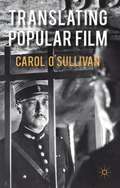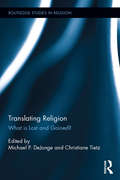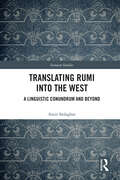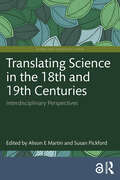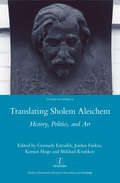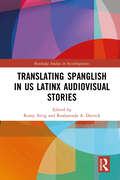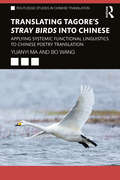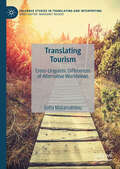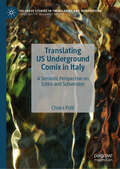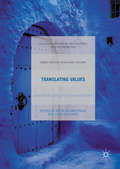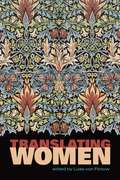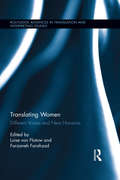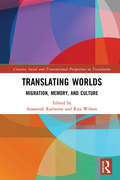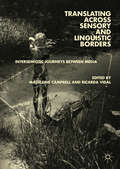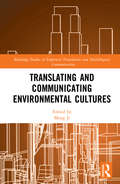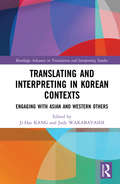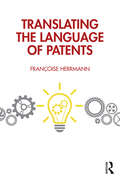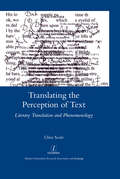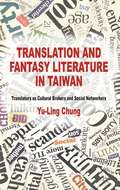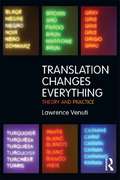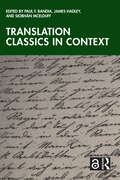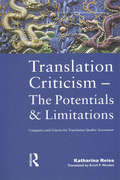- Table View
- List View
Translating Popular Film
by Carol O'Sullivan 2011A ground-breaking study of the roles played by foreign languages in film and television and their relationship to translation. The book covers areas such as subtitling and the homogenising use of English, and asks what are the devices used to represent foreign languages on screen?
Translating Religion: What is Lost and Gained? (Routledge Studies in Religion)
by Michael DeJonge Christiane TietzTranslating Religion advances thinking about translation as a critical category in religious studies, combining theoretical reflection about processes of translation in religion with focused case studies that are international, interdisciplinary, and interreligious. By operating with broad conceptions of both religion and translation, this volume makes clear that processes of translation, broadly construed, are everywhere in both religious life and the study of religion; at the same time, the theory and practice of translation and the advancement of translation studies as a field has developed in the context of concerns about the possibility and propriety of translating religious texts. The nature of religions as living historical traditions depends on the translation of religion from the past into the present. Interreligious dialogue and the comparative study of religion require the translation of religion from one tradition to another. Understanding the historical diffusion of the world’s religions requires coming to terms with the success and failure of translating a religion from one cultural context into another. Contributors ask what it means to translate religion, both textually and conceptually, and how the translation of religious content might differ from the translation of other aspects of human culture. This volume proposes that questions on the nature of translation find particularly acute expression in the domains of religion, and argues that theoretical approaches from translation studies can be fruitfully brought to bear on contemporary religious studies.
Translating Rumi into the West: A Linguistic Conundrum and Beyond (Iranian Studies)
by Amir SedaghatFocusing on Rumi, the best-selling Persian mystical poet of the 13th century, this book investigates the reception of his work and thought in North America and Europe – and the phenomenon of ‘Rumimania’ – to elucidate the complexities of intercultural communication between the West and the Iranian and Islamic worlds. Presenting tens of examples from the original and translated texts, the book is a critical analysis of various dimensions of this reception, outlining the difficulties of translating the text but also exploring how translators of various times and languages have performed, and explaining why the quality of reception varies. Topics analysed include the linguistic and pragmatic issues of translation, comparative stylistics and poetics, and non-textual factors like the translator’s beliefs and the political and ideological aspects of translation. Using a broad theoretical framework, the author highlights the difficulties of intercultural communication from linguistic, semiotic, stylistic, poetic, ethical, and sociocultural perspectives. Ultimately, the author shares his reflections on the semiotic specificities of Rumi’s mystical discourse and the ethics of translation generally. The book will be valuable to scholars and students of Islamic philosophy, Iranian studies, and translation studies, but will appeal to anyone interested in the cultural dichotomies of the West and Islam.
Translating Science in the 18th and 19th Centuries: Interdisciplinary Perspectives (Science and Technology Studies)
by Alison E. Martin and Susan PickfordThis book explores the role of translation in shaping the knowledge-sharing processes that were and are seminal to scientific endeavour. It considers the mechanisms by which eighteenth- and nineteenth-century European science writing travelled within and beyond its home continent and non- European science was taken up in a colonial context. Using insights from fields of research including book history and textual studies to investigate the paratextual framing, stylistic choices, rhetorical devices, and modes of expression deployed by scientific writers – key to shaping a work’s credibility and its author’s integrity –it argues that translators are central, yet largely overlooked, mediators in this creative process.Encompassing West Africa, China, the Middle East, India, South America, Europe, and the Ottoman Empire, this volume comprises case studies working with around a dozen different languages to gain a sense of how scientific narratives were evolving both within and across an increasingly global intellectual commons in a key period in the development of the natural sciences, medicine, and technology.Part of the Science and Technology Studies series, the volume will be indispensable for scholars and researchers of science and technology studies, philosophy of science, translation studies, gender studies, English literature, and philosophy in general.
Translating Sholem Aleichem: History, Politics and Art
by Gennady EstraikhSholem Aleichem, whose 150th anniversary was commemorated in March 2009, remains one of the most popular Yiddish authors. But few people today are able to read the original. Since the 1910s, however, Sholem Aleichem's works have been known to a wider international audience through numerous translations, and through film and theatre adaptations, most famouslyFiddler on the Roof. This volume examines those translations published in Europe, with the aim of investigating how the specific European contexts might have shaped translations of Yiddish literature. With the contributions: Olga Litvak- Found in Translation: Sholem Aleichem and the Myth of the Ideal Yiddish Reader Alexander Frenkel- Sholem Aleichem as a Self-Translator Eugenia Prokop-Janiec- Sholem Aleichem and the Polish-Jewish Literary Audience Gennady Estraikh- Soviet Sholem Aleichem Roland Gruschka- 'Du host zikh a denkmol af eybik geshtelt': The Sovietization and Heroization of Sholem Aleichem in the 1939 Jubilee Poems Mikhail Krutikov- A Man for All Seasons: Translating Sholem Aleichem into Soviet Ideological Idiom Gabriella Safran- Four English Pots and the Evolving Translatability of Sholem Aleichem Sabine Koller- On (Un)Translatability: Sholem Aleichem's Ayznban-geshikhtes (Railroad Stories) in German Translation Alexandra Hoffman- Laughing Matters: Translation and Irony in 'Der gliklekhster in Kodne' Kerstin Hoge- Lost in Marienbad: On the Literary Use of the Linguistic Openness of Yiddish Anna Verschik- Sholem Aleichem in Estonian: Creating a Tradition Jan Schwarz- Speaking Tevye der milkhiker in Translation: Performance, Humour, and World Literature
Translating Spanglish in US Latinx Audiovisual Stories (Routledge Studies in Sociolinguistics)
by Attig, Edited by RemyThis collection showcases interdisciplinary perspectives on how Spanglish is translated across different forms of audiovisual media for different audiences in the US Latinx content.The volume explores the ways in which Spanglish is used in American media to portray the hallmark linguistic characteristics of the communities in which they are set, but also the different scholarly approaches employed to analyze them in existing research. The first section looks at the interplay of code-switching, translanguaging, and linguistic identity in television shows and films but also podcasts, music, and other emergent forms of media. The second part examines US Latinx stories through the lens of translation studies, with chapters showcasing different lines of inquiry within contemporary translation scholarship, including accessibility via captioning and interlingual translation through subtitling and dubbing. Taken together, the volume offers a holistic view on how Spanglish is translated in US Latinx stories towards paving the way for future research in this context but also on multilingual and translingual audiovisual stories more broadly.This book will be of interest to scholars in sociolinguistics, translation studies, language and media, media studies, and Latinx studies.
Translating Tagore's Stray Birds into Chinese: Applying Systemic Functional Linguistics to Chinese Poetry Translation (Routledge Studies in Chinese Translation)
by Bo Wang Yuanyi MaTranslating Tagore’s ‘Stray Birds’ into Chinese explores the choices in poetry translation in light of Systemic Functional Linguistics (SFL) and illustrates the ways in which readers can achieve a deeper understanding of translated works in English and Chinese. Focusing on Rabindranath Tagore’s ‘Stray Birds’, a collection of elegant and philosophical poems, as a source text, Ma and Wang analyse four Chinese target texts by Zheng Zhenduo, Yao Hua, Lu Jinde and Feng Tang and consider their linguistic complexities through SFL. This book analyses the source text and the target texts from the perspectives of the four strata of language, including graphology, phonology, lexicogrammar and context. Ideal for researchers and academics of SFL, Translation Studies, Linguistics, and Discourse Analysis, Translating Tagore’s ‘Stray Birds’ into Chinese provides an in-depth exploration of SFL and its emerging prominence in the field of Translation Studies.
Translating Texts: An Introductory Coursebook on Translation and Text Formation
by Brian James Baer Christopher D. MellingerClear and accessible, this textbook provides a step-by-step guide to textual analysis for beginning translators and translation students. Covering a variety of text types, including business letters, recipes, and museum guides in six languages (Chinese, English, French, German, Russian, and Spanish), this book presents authentic, research-based materials to support translation among any of these languages. Translating Texts will provide beginning translators with greater text awareness, a critical skill for professional translators. Including discussions of the key theoretical texts underlying this text-centred approach to translation and sample rubrics for (self) assessment, this coursebook also provides easy instructions for creating additional corpora for other text types and in other languages. Ideal for both language-neutral and language-specific classroom settings, this is an essential text for undergraduate and graduate-level programs in modern languages and translation.
Translating Tourism: Cross-Linguistic Differences of Alternative Worldviews (Palgrave Studies in Translating and Interpreting)
by Sofia MalamatidouThis book provides a large-scale empirical multilingual study of crosslinguistic differences in the language of destination promotion. The book explores how tourism texts are negotiated in translation, and how the translated texts reflect and reconcile different worldviews, that of the destination population and that of the tourist. Using the 2-million-word TrAIL (Tourism Across and & In-between Languages) corpus, which includes examples from official tourism websites in English, French, Greek, and Russian as well as translations between these languages, the author explores the differences in the key linguistic means used in destination promotion and what these linguistic choices can tell us about how these societies view the world around them differently. The book’s interdisciplinary focus makes it relevant to not only practising translators, but also students and scholars interested in issues surrounding tourism, promotion, and translation, as well as destination promoters who want to better understand the role that language and translation play in tourism promotion.
Translating US Underground Comix in Italy: A Semiotic Perspective on Satire and Subversion (Palgrave Studies in Translating and Interpreting)
by Chiara PolliThis book analyses 1960s-1970s US underground comix, a &‘counterculture&’ art form that satirised mainstream values and taboos. The author observes comix in their multimodal components in the original English-language versions and in their Italian translations by unpacking the several layers of verbal and visual meaning-making. She then goes on to scrutinise translation and resemiotisation processes, including modifications, mitigations, and omissions, encompassing socio-historical and cross-cultural perspectives. The book argues that translation, meant to bridge two (counter-)cultures, served as a gatekeeper instead, zooming in on certain themes, while inadvertently overlooking or purposefully manipulating others, with an outcome close to censorship. The volume is divided into nine chapters. Chapter 1 summarises the aims and scope of the volume. Chapter 2 introduces comix as a subversive phenomenon. Chapter 3 illustrates the theoretical and methodological framework of analysis, based on semiotics and multimodality. Chapter 4 presents the corpus of Italian translations, which includes works translated between 1968 and 2022 by both mainstream and alternative publishers. In Chapters 5-8, Italian translations of comix dealing with such controversial themes as sex, drugs, political struggle, and religion are analysed, with qualitative observations of several translations of the same comix provided to highlight changing times, cultural frames, ideologies, editorial policies, and target audiences. Chapter 9 discusses the findings of these observations and maintains that, as a recursive translation strategy, seditious contents were mitigated, trivialised, or censored by adopting light-hearted frames so that potentially problematic contents could be left out. With its linguistic, translational, and intercultural analyses, this volume will be useful for researchers of linguistics, semiotics, translation, and comics studies.
Translating Values
by John Gillespie Piotr BlumczynskiThis collection explores the central importance of values and evaluative concepts in cross-cultural translational encounters. Written by a group of international scholars from a diverse range of linguistic and cultural backgrounds, the chapters in this book consider what it means to translate cultures by examining core values and their relationship to key evaluative concepts (such as authenticity, clarity, home, honour, or justice) and how they influence the complex multidimensional process of translation. This book will be of interest to academics studying cross-cultural and inter-linguistic interactions, to translators and interpreters, students of translation and of modern languages, and all those dealing with multilingual and multicultural settings.
Translating War: Literature and Memory in France and Britain from the 1940s to the 1960s (Palgrave Studies in Languages at War)
by Angela KershawThis book examines the role played by the international circulation of literature in constructing cultural memories of the Second World War. War writing has rarely been read from the point of view of translation even though war is by definition a multilingual event, and knowledge of the Second World War and the Holocaust is mediated through translated texts. Here, the author opens up this field of research through analysis of several important works of French war fiction and their English translations. The book examines the wartime publishing structures which facilitated literary exchanges across national borders, the strategies adopted by translators of war fiction, the relationships between translated war fiction and dominant national memories of the war, and questions of multilingualism in war writing. In doing so, it sheds new light on the political and ethical questions that arise when the trauma of war is represented in fiction and through translation. This engaging work will appeal to students and scholars of translation, cultural memory, war fiction and Holocaust writing.
Translating Women: Different Voices And New Horizons (Perspectives on Translation)
by Luise Von FlotowFeminist theory has been widely translated, influencing the humanities and social sciences in many languages and cultures. However, these theories have not made as much of an impact on the discipline that made their dissemination possible: many translators and translation scholars still remain unaware of the practices, purposes and possibilities of gender in translation. Translating Women revives the exploration of gender in translation begun in the 1990s by Susanne de Lotbinière-Harwood’s Re-belle et infidèle/The Body Bilingual (1992), Sherry Simon’s Gender in Translation (1996), and Luise von Flotow’s Translation and Gender (1997). Translating Women complements those seminal texts by providing a wide variety of examples of how feminist theory can inform the study and practice of translation. Looking at such diverse topics as North American chick lit and medieval Arabic, Translating Women explores women in translation in many contexts, whether they are women translators, women authors, or women characters. Together the contributors show that feminist theory can apply to translation in many new and unexplored ways and that it deserves the full attention of the discipline that helped it become internationally influential.
Translating Women: Different Voices and New Horizons (Routledge Advances in Translation and Interpreting Studies)
by Luise Von Flotow Farzaneh FarahzadThis book focuses on women and translation in cultures 'across other horizons' well beyond the European or Anglo-American centres. Drawing on transnational feminist connections, its editors have assembled work from four continents and included articles from Morocco, Mexico, Sri Lanka, Turkey, China, Saudi Arabia, Columbia and beyond. Thirteen different chapters explore questions around women's roles in translation: as authors, or translators, or theoreticians. In doing so, they open new territories for studies in the area of 'gender and translation' and stimulate academic work on questions in this field around the world. The articles examine the impact of 'Western' feminism when translated to other cultures; they describe translation projects devised to import and make meaningful feminist texts from other places; they engage with the politics of publishing translations by women authors in other cultures, and the role of women translators play in developing new ideas. The diverse approaches to questions around women and translation developed in this collection speak to the volume of unexplored material that has yet to be addressed in this field.
Translating Worlds: Migration, Memory, and Culture (Creative, Social and Transnational Perspectives on Translation)
by Susannah RadstoneThis international and interdisciplinary volume explores the relations between translation, migration, and memory. It brings together humanities researchers from a range of disciplines including history, museum studies, memory studies, translation studies, and literary, cultural, and media studies to examine memory and migration through the interconnecting lens of translation. The innovatory perspective adopted by Translating Worlds understands translation’s explanatory reach as extending beyond the comprehension of one language by another to encompass those complex and multi-layered processes of parsing by means of which the unfamiliar and the familiar, the old home and the new are brought into conversation and connection. Themes discussed include: How memories of lost homes act as aids or hindrances to homemaking in new worlds. How cultural memories are translated in new cultural contexts. Migration, affect, memory, and translation. Migration, language, and transcultural memory. Migration, traumatic memory, and translation.
Translating across Sensory and Linguistic Borders: Intersemiotic Journeys between Media
by Ricarda Vidal Madeleine CampbellThis book analyses intersemiotic translation, where the translator works across sign systems and cultural boundaries. Challenging Roman Jakobson’s seminal definitions, it examines how a poem may be expressed as dance, a short story as an olfactory experience, or a film as a painting. This emergent process opens up a myriad of synaesthetic possibilities for both translator and target audience to experience form and sense beyond the limitations of words. The editors draw together theoretical and creative contributions from translators, artists, performers, academics and curators who have explored intersemiotic translation in their practice. The contributions offer a practitioner’s perspective on this rapidly evolving, interdisciplinary field which spans semiotics, cognitive poetics, psychoanalysis and transformative learning theory. The book underlines the intermedial and multimodal nature of perception and expression, where semiotic boundaries are considered fluid and heuristic rather than ontological. It will be of particular interest to practitioners, scholars and students of modern foreign languages, linguistics, literary and cultural studies, interdisciplinary humanities, visual arts, theatre and the performing arts.
Translating and Communicating Environmental Cultures (Routledge Studies in Empirical Translation and Multilingual Communication)
by Meng JiEnvironmental translation studies has gained momentum in recent years as a new area of research underscored by the need to communicate environmental concerns and studies across cultures. The dissemination of translated materials on environmental protection and sustainable development has played an instrumental role in transforming local culture and societies. This edited book represents an important effort to advance environmental studies by introducing the latest research on environmental translation and cross-cultural communication. Part I of the book presents the newest research on multilingual environmental resource development based at leading research institutes in Europe, Latin America, North America, and the Asia-Pacific. Part II offers original, thought-provoking linguistic, textual and cultural analyses of environmental issues in genres as diverse as literature, nature-based tourism promotion, environmental marketing, environmental documentary, and children’s reading. Chapters in this book represent original research authored by established and mid-career academics in translation studies, computer science, linguistics, and environmental studies around the world. The collection provides engaging reading and references on environmental translation and communication to a wide audience across academia.
Translating and Interpreting in Korean Contexts: Engaging with Asian and Western Others (Routledge Advances in Translation and Interpreting Studies)
by Judy Wakabayashi Ji-Hae KangThe focus of this volume is on how the people of the Korean Peninsula—historically an important part of the Sinocentric world in East Asia and today a vital economic and strategic site—have negotiated oral and written interactions with their Asian neighbors and Europeans in the past and present through the mediation of translators and interpreters. These encounters have been shaped by political, social, and cultural factors, including the shared use of the Chinese writing system in East Asia for many centuries, attitudes toward other Asians and Westerners, and perceptions of Korean identity in relation to these Others. After exploring aspects of historical interactions, the volume addresses how the role and practice of translation and interpreting have recently evolved as a result of the development of digital technology, an increase in the number of immigrants, and changes in political and cultural dynamics in the region. It covers a range of historical and contemporary aspects, genres, and venues that extend beyond the common yet restrictive focus on literary translation and includes discussions of translator training and academic studies of translation and interpreting in Korea.
Translating the Language of Patents
by Françoise HerrmannThis book is a guide to translating the language of patents in view of avoiding costly translation errors. Errors that might hinder the examination process for granting patents, or that might make patents undefendable in a context of litigation.The 42 sections of this book each identify different provisions of the law for their relevance to translation. These provisions govern language uses, right down to the use of punctuation. Each of the sections present findings, both in terms of the relevant provisions identified, and their specific significance to translation. Exemplified translations focus on French and English, but when there is a consensus across Intellectual property systems, multilingual parallelism is highlighted. Wherever relevant, provisions of specific rules and regulations are presented and exemplified in the three official languages of the European Patent Office (EPO), English, French, and German and the three official languages of the United Nations World Intellectual Property Organization (WIPO), English, French, and Spanish.Written by an experienced teacher, patent translator, and author of the blog, Patents on the Soles of Your Shoes, this is a rigorously researched, authoritative, and comprehensive guide for all professional translators working on patents, and for students and translators working in legal translation. Accompanying e-resources are available on the Routledge Translation studies portal (routledgetranslationstudiesportal.com) including information on how to use this book in courses.
Translating the Perception of Text: Literary Translation and Phenomenology
by Clive ScottTranslation often proceeds as if languages already existed, as if the task of the translator were to make an appropriate selection from available resources. Clive Scott challenges this tacit assumption. If the translator is to do justice to himself/herself as a reader, if the translator is to become the creative writer of his/her reading, then the language of translation must be equal to the translators perceptual experience of, and bodily responses to, source texts. Each renewal of perceptual and physiological contact with a text involves a renewal of the ways we think language and use our expressive faculties (listening, speaking, writing). Phenomenology and particularly the phenomenology of Merleau-Ponty underpins this new approach to translation. The task of the translator is tirelessly to develop new translational languages, ever to move beyond the bilingual into the multilingual, and always to remember that language is as much an active instrument of perception as an object of perception. Clive Scott is Professor Emeritus of European Literature at the University of East Anglia, and a Fellow of the British Academy.
Translation (The New Critical Idiom)
by Susan BassnettIn a time when millions travel around the planet; some by choice, some driven by economic or political exile, translation of the written and spoken word is of ever increasing importance. This guide presents readers with an accessible and engaging introduction to the valuable position translation holds within literature and society. Leading translation theorist, Susan Bassnett traces the history of translation, examining the ways translation is currently utilised as a burgeoning interdisciplinary activity and considers more recent research into developing technologies and new media forms. Translation displays the importance of translation across disciplines, and is essential reading for students and scholars of translation, literary studies, globalisation studies, and ancient and modern languages.
Translation And Fantasy Literature In Taiwan
by Yu-Ling ChungThis book examines the rise in popularity of fantasy literature in Taiwan and the crucial but often invisible role that translators have played in making this genre widely available. Topics covered include global fantasy fever, Chinese fantasy, game industry, the social status of translators, and the sociological direction of translations studies.
Translation Changes Everything: Theory and Practice
by Lawrence VenutiIn Translation Changes Everything leading theorist Lawrence Venuti gathers fourteen of his incisive essays since 2000. The selection sketches the trajectory of his thinking about translation while engaging with the main trends in research and commentary. The issues covered include basic concepts like equivalence, retranslation, and reader reception; sociological topics like the impact of translations in the academy and the global cultural economy; and philosophical problems such as the translator’s unconscious and translation ethics. Every essay presents case studies that include Venuti’s own translation projects, illuminating the connections between theoretical concepts and verbal choices. The texts, drawn from a broad variety of languages, are both humanistic and pragmatic, encompassing such forms as poems and novels, religious and philosophical works, travel guidebooks and advertisements. The discussions all explore practical applications, whether writing, publishing, reviewing, teaching or studying translations. Venuti’s aim is to conceive of translation as an interpretive act with far-reaching social effects, at once enabled and constrained by specific cultural situations. This latest chapter in his developing work is essential reading for translators and students of translation alike.
Translation Classics in Context
by Paul F. BandiaTranslation Classics in Context carefully considers the relationship between translation and the classics. It presents readers with revelatory and insightful case studies that investigate translations produced as part of nexuses of colonial resistance and liberation across Africa and in Ireland; translations of novels and folklore collections that influence not just other fictions, but stage productions and entire historical disciplines; struggles over Ukrainian and Russian literature and how it is shaped and transferred; and the role of the academy and the curriculum in creating notions of classic translations.Along the way it covers oral poetry, saints, scholars, Walter Scott and Jules Verne, not to mention Leo Tolstoy and the Corpse Bride making her way from folklore to Frankenstein and into the world of Disney animation. Contributors are all leading scholars, and the book is accessible and engaging, assuming no specialist knowledge.Chapter 6 of this book is freely available as a downloadable Open Access PDF at http://www.taylorfrancis.com under a Creative Commons Attribution-Non Commercial-No Derivatives (CC-BY-NC-ND) 4.0 license.
Translation Criticism – The Potentials And Limitations: Categories and Criteria for Translation Quality Assessment
by Katharina ReissKatharina Reiss's now classic contribution to Translation Studies, Möglichkeiten und Grenzen der Übersetzungskritik: Kategorien und Kriteren für eine sachgerechte Beurteilung von Übersetzungen, first appeared in 1971. This is the first English translation of this major work, allowing students and practitioners of translation in the English-speaking world to make more extensive use of Reiss's pioneering treatment of a central theme in translation: how to develop reliable criteria for the systematic evaluation of translations. Using a wealth of interesting and varied examples, Reiss offers a systematic and illuminating text typology, a pragmatic approach to text analysis, a functional perspective on translation and a hermeneutic view of the translator, thus accounting for some of the most important aspects of the translation process: the text (both source and target versions), the conditions which determine the translator's decisions, and the translator as an individual whose personal interpretation has to be respected by any critic. In the three decades since Katharina Reiss wrote, the terminology of translation studies has evolved on many fronts. Erroll Rhodes' translation strikes an optimal balance between remaining faithful to the original presentation and using terminology that today's reader would generally understand and value.
